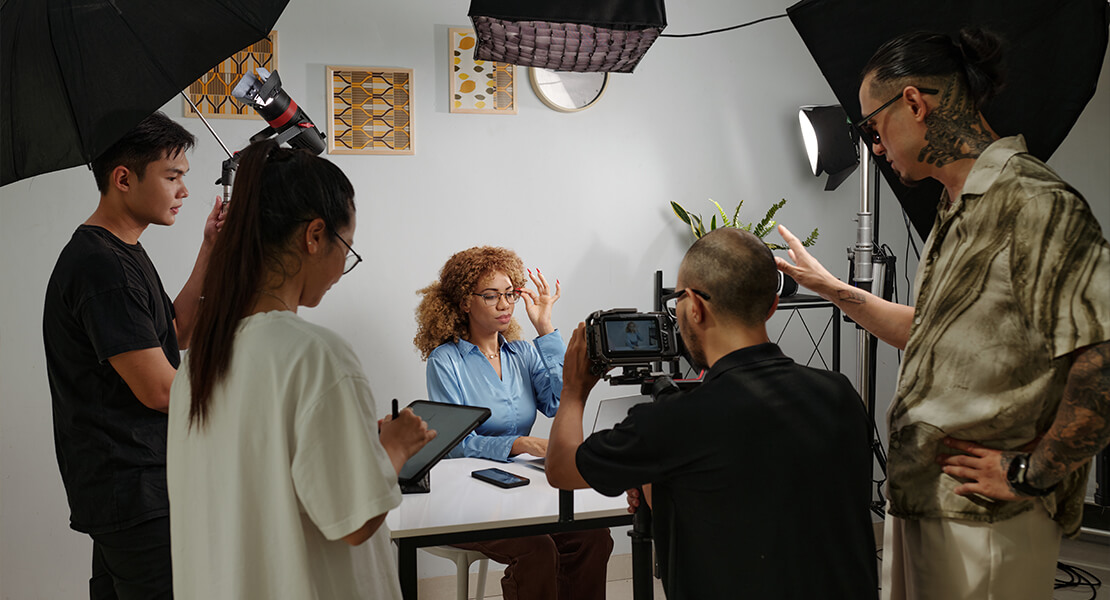
You’ve got a brilliant idea. A product or service you truly believe in. Maybe it solves a common problem, introduces a new way of doing something, or just makes life that little bit easier. But here’s the challenge: how do you explain it clearly and quickly—before your audience scrolls past, clicks away, or tunes out?
That’s where explainer videos come in. And if you’re a startup, having one isn’t just a nice touch—it could be one of the smartest investments you make.
When you’re just starting out, every second of someone’s attention matters. You don’t yet have brand recognition, customer testimonials, or word-of-mouth working in your favour. What you do have is your story—and how effectively you tell it could be the difference between someone bouncing off your website and someone clicking “Sign me up.”
An explainer video helps you grab attention fast and deliver your message in a way that’s visual, engaging, and easy to understand. It adds clarity, builds trust, and gives your audience a reason to care. Whether you’re raising funding, launching a product, or building your first customer base, it’s a tool that can move the needle—fast.
In short, it’s your pitch—on autoplay.
What Exactly Is an Explainer Video?
Let’s start with the basics. An explainer video is a short, punchy piece of content—usually 60 to 90 seconds—that tells people what your product or service is, how it works, and why it matters. It simplifies. It visualises. And most importantly, it connects.
It’s not a dry corporate video or a full-blown ad campaign. It’s storytelling with purpose. Think of it as your elevator pitch—brought to life with motion, sound, and clarity.
Explainer videos typically follow a simple but effective structure: they highlight a problem, introduce the solution (your product or service), and then show how it works, ending with a clear call to action. This structure works because it speaks directly to your audience’s pain points, offers them a solution, and gives them a reason to take the next step—all within a very short space of time.

You’ve probably seen explainer videos on homepages, landing pages, crowdfunding campaigns, and across social media. They come in all shapes and styles—2D animation, whiteboard sketches, kinetic typography, live action with overlays, and even stop motion. The format doesn’t matter as much as the message and how effectively it’s delivered.
What makes explainer videos stand out is their ability to combine voice, visuals, and tone in a way that text or static images simply can’t. They can bring emotion, personality, and brand identity into the mix while also being incredibly practical. Whether you’re launching a new product, pitching an idea, or trying to onboard users, a well-crafted explainer helps you get to the point—without losing your audience.
In today’s attention-poor landscape, that’s gold dust. People don’t want to read through paragraphs of information—they want to “get it” fast. An explainer video makes that possible, all while keeping them engaged and informed.
Why Startups in Particular Need One
When you’re new to the market, you’re working with limited time, limited resources, and, let’s be honest, limited attention spans. You can’t afford to lose potential customers in a sea of jargon or unclear messaging.
An explainer video does the heavy lifting. It gives your audience the ‘aha!’ moment in under two minutes. It’s your digital first impression—and in the startup world, those matter more than you might think.
Here’s why explainer videos should be high on your startup’s to-do list:
1. They Make Complex Ideas Simple
Startups are often built around innovation. You’ve come up with something
different, something smarter—but it might not be immediately obvious to someone
unfamiliar with your space.
Explainer videos break things down in a way that’s engaging and easy to follow. Whether it’s a tech platform, a new app, or a disruptive service, animation and voiceover can work together to turn complexity into clarity. They strip away the fluff and focus on what really matters to the user. You can guide your audience through a concept step by step, all while keeping things visually interesting and accessible.
And once people understand what you offer? They’re far more likely to trust it—and buy into it.
2. They Keep People on Your Website
Here’s a stat that’s hard to ignore: websites with video keep visitors around
longer. Why? Because people are far more likely to watch a short video than
read through blocks of text.

Your explainer video becomes a centrepiece. It draws the eye, hooks interest, and guides the viewer deeper into your brand. The video sets the tone and creates a sense of momentum—people naturally want to know what comes next. You can use it to lead into testimonials, product pages, or sign-up forms.
And the longer they stick around, the more likely they are to convert.
3. They Help You Pitch Better
If you’re pitching to investors, partners, or customers, having a polished
explainer video can instantly boost your credibility. It shows that you’ve
thought about your messaging, invested in your brand, and know how to
communicate clearly.
It also shows that you respect your audience’s time. Instead of burying them in a dense presentation or overloading a slide deck, you can open with a video that gets straight to the point. It’s a confidence booster—not just for your audience, but for you too. It sets the stage and helps create a memorable, professional first impression.
Plus, videos are easy to share. Whether it’s embedded in a pitch deck, linked in an email, or shared on LinkedIn, your explainer can do the talking when you’re not in the room.
4. They Work Brilliantly on Social Media
Social media platforms love video. It’s prioritised in algorithms, more likely to be engaged with, and easier to digest. With a good explainer video, you’ve got content that fits perfectly on Instagram, LinkedIn, YouTube, or TikTok—depending on your audience.
And it’s not just about the full video, either. You can chop it into bite-sized snippets, use stills as graphics, or turn key lines into motion-based quotes. That versatility is golden when you’re trying to stay visible without reinventing the wheel every week. You get more reach, more engagement, and more bang for your content buck.
Plus, video content is more shareable, meaning your audience can become part of your distribution strategy. The more people engage, the more visibility your brand gains organically. One piece of content becomes many—and the impact grows with every view.
5. They Build Trust Faster
In the early stages of a business, trust is everything. People don’t yet know
you. They don’t know your team or your track record. But a well-crafted
explainer video adds warmth, confidence, and legitimacy.
It shows that you care about clarity—that you’re not just pushing a product, but helping people understand it. It’s your chance to be human, even if you’re not face-to-face. You can set the tone, show empathy, and make your values shine through. People buy from people—and even in a digital world, connection still matters. A professional explainer signals that you’re serious, organised, and worth paying attention to. And when your message feels transparent and trustworthy, your audience is far more likely to take the next step.
All of that helps build a relationship—and trust leads to conversion.
Animation vs. Live Action—Which Is Best?
Both have their place, but for startups, animation often wins out. Here’s why:

It’s more versatile: You can illustrate ideas that are hard (or impossible) to film. Want to show data flowing through a network? Done. Need to take viewers inside a mobile app or visualise an abstract concept like “cloud security” or “productivity”? Animation can handle it with ease. You’re not restricted by physical limitations—you can bend reality to serve the story. It opens up endless creative possibilities, no matter how niche your subject.
It’s future-proof: Easy to update if your messaging changes. You can swap out scenes, change text, or re-record a voiceover without starting from scratch. This is especially handy for startups, where products evolve quickly. Instead of scrapping your whole video, you can make small edits that keep your content fresh and relevant. That means your video keeps working for you, even as your business grows and shifts.
It’s budget-friendly: No need for sets, actors, or locations. You avoid the costs of hiring talent, renting gear, or booking studio time. That also means fewer logistical headaches—no need to worry about weather, travel, or scheduling conflicts. You can get high-quality results without the high production price tag. Plus, once you’ve developed an animated style, you can reuse it across future videos, saving even more.
It feels polished: Even a small team can look professional with the right animation. Clean visuals, smooth transitions, and thoughtful storytelling give your brand a refined, intentional feel. You don’t need a huge production crew to look like you’ve got your act together. It’s a smart shortcut to making a great first impression. And that perception of quality can give your startup an instant boost in credibility.
That said, if you’ve got a physical product or want to put a real face to your business, live action can work wonders too—especially when combined with animated overlays or motion graphics.
What Makes a Great Explainer Video?
Not all explainer videos are created equal. To make one that truly works, you need to get a few things right:
- Start with a strong script: Your story is everything. Focus on benefits, not just features. Keep it conversational. The script is the backbone of your video—without a solid one, even the best visuals won’t land. Start with the problem your audience is facing, and position your product as the clear, relatable solution. Use everyday language, not jargon. And always write with the viewer in mind—what do they care about, and what’s in it for them?
- Keep it short: Aim for 60 to 90 seconds. Attention spans are short—respect them. The goal is clarity, not completeness. You don’t need to say everything—just enough to spark interest and invite the next step. Think of your explainer video as the hook, not the whole pitch. Cut anything that doesn’t serve the story or move it forward. And if it helps, use the rule of one: one idea, one message, one takeaway.
- Use visuals to enhance, not repeat: The visuals should add meaning, not just mimic the voiceover. Animation should be working in harmony with the script—not echoing it word-for-word. Use motion, transitions, and visual metaphors to support what’s being said or to offer a new layer of meaning. If your voiceover says “We simplify your workflow,” the animation could show a chaotic process transforming into a sleek, organised system. This keeps the viewer engaged and avoids redundancy. Good visual storytelling is about showing, not telling.
- End with a call to action: What should the viewer do next? Make it clear and compelling. Whether it’s signing up, booking a demo, or visiting your website, the CTA should feel like a natural next step. Don’t be vague—“learn more” isn’t always enough. Remind the viewer of the value you’ve just shown them, and give them a reason to act now. Even better if the CTA is visually reinforced, like a clickable button or animated prompt that stands out.
How to Get Started
You don’t need a huge budget or an in-house video team to get going. There are freelancers, animation studios, and even online tools that specialise in explainer videos for startups. The key is to find the right fit for your brand—someone (or something) that understands your message and can bring it to life in a way that feels authentic.

Start with your message—what problem do you solve, and why should anyone care? Be brutally clear here. If you can’t explain your product or service in one or two sentences, chances are your audience won’t get it either. Once you’ve nailed your core message, everything else becomes easier. That includes your script, visuals, and even your call to action.
From there, build a script that flows naturally. Begin with the problem, introduce your solution, then highlight how it works and what makes it better. Don’t just list features—show benefits. Focus on the transformation your product delivers. And keep the tone in line with your brand. Are you a fun, energetic startup? A calm and trustworthy voice of reason? Your explainer video should reflect that.
Next, sketch out the visual flow. This doesn’t have to be full-blown storyboarding—you can use simple thumbnails or flowcharts to map out the progression. This helps visualise how the voiceover and motion will play together and lets you spot any pacing issues early on.
When it comes to production, choose what works for your current stage. Tools like Powtoon, Animaker, and Vyond let you build basic explainer videos yourself if you’re on a tight budget. If you’ve got a bit more to spend, working with an experienced freelancer or animation studio can elevate your video with custom graphics, music, and voice talent. Look for portfolios with a strong storytelling sensibility, not just flashy visuals.
And remember: done is better than perfect. A simple, clear explainer is far more powerful than a flashy, confusing one. Focus on delivering your message well, not on cramming in every detail. You can always create follow-up videos or expand on your story later.
At the end of the day, your goal is clarity, confidence, and connection. If your audience walks away saying, “Now I get it,” you’ve done your job.
Final Thoughts
In the fast-paced world of startups, clarity is currency. If people don’t get what you do—and why it matters—they won’t stick around long enough to find out.
An explainer video is your chance to cut through the noise, show up with confidence, and turn curiosity into action. It’s not just a marketing tool—it’s a storytelling superpower.
When done well, it becomes the heartbeat of your brand communication. It helps potential customers understand your product. It reassures investors that you know how to articulate your value. And it gives your team a clear, consistent way to explain what you’re all about.
It’s also one of the few assets that works across every stage of the journey—from awareness to conversion to onboarding. You can use it on your website, in pitch decks, on social media, at events, and even in customer support.
So if you haven’t got one yet, maybe now’s the time to bring your brand to life in 90 seconds or less.
Start simple. Focus on the message. Choose a style that fits your voice. And don’t overthink it—because when you get it right, the impact can be bigger than you expect. After all, in a world full of static noise, motion speaks.
If you’d like to consider creating an explainer video for your startup, get in touch with us here at Spiel for a free consult with one of our experts.

